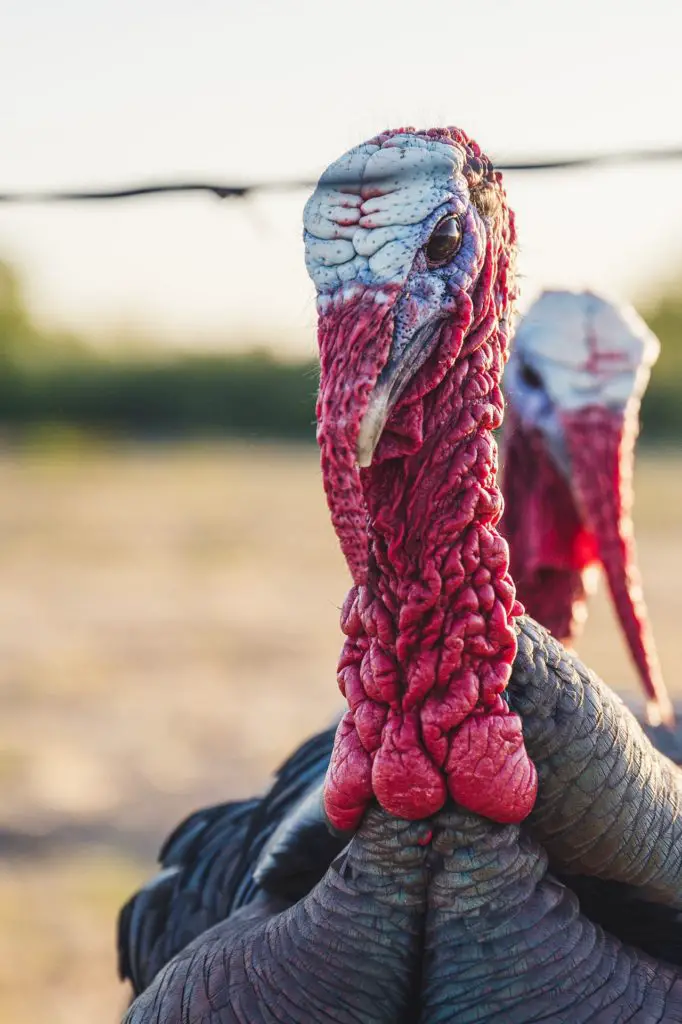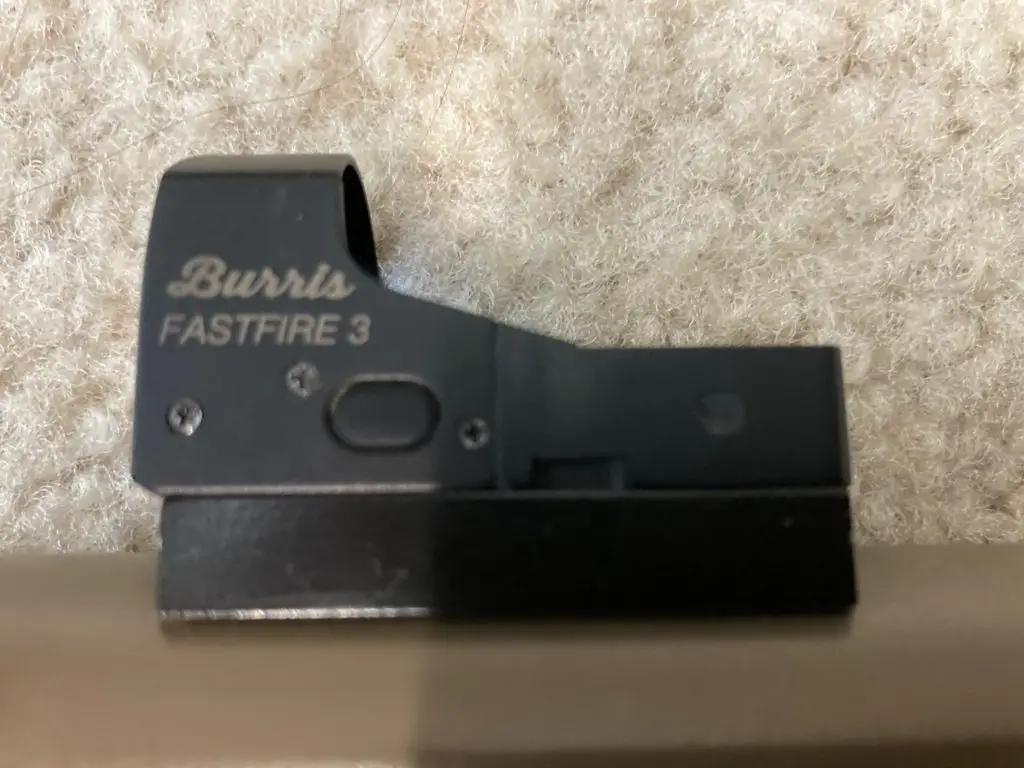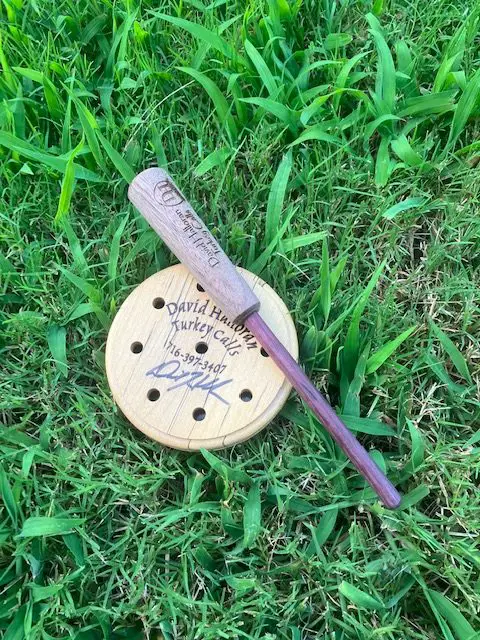
Slate turkey calls can be intimidating to the beginning turkey hunter.
The first issue is the name. Is it a slate call, a pot call, or a friction call? The truth is, they’re all the same thing. While not all turkey pot calls have a slate surface, many turkey hunters still call them slate calls (even if they’re glass, aluminum, or some other material). And even though a box call uses friction to make sound, most are referring to pot calls when they talk about friction calls.
The second issue is the number of options available for slate turkey calls. There are so many surface types. Which should you choose? After you choose a pot call, you then have to pair it with a good striker. Not all strikers are good for all calls. Just keep reading. I’ll cover the options in depth further down in the article.
A third issue that hangs newbies up at times is conditioning. While it may sound complicated, it can be as easy as following some simple instructions. Don’t sweat it. I’ll cover that in further detail below.
Finally, how in the heck do you use this thing? At first, you may not be able to get any sound out of a call at all. Well then, follow my step by step guide below and it will get you going in the right direction at least.
But before we cover all of this, let’s jump into why you would even want to use a slate call in the first place.
Why Use A Slate Call
If variety is the spice of life, then the slate turkey call is the spice of turkey calls. There are so many combinations of surfaces, pots, and strikers that can be combined to make many different turkey sounds with the same basic calling method.
That means you only have to learn one calling technique to make appropriate calls for many different situations with many different tones.
And while mastering the turkey pot call takes some practice, I believe that most beginners will find the pot call easier to learn than the mouth call or box call. It is certainly way easier to learn than a trumpet call.
In my opinion, the mechanics of calling are more compact and easier to replicate on a slate call than on a box call. Unlike a mouth call, you don’t have all the issues with gag reflex, diaphragm pressure, and fit with a pot call.
Because of these reasons, I recommend beginners start with the turkey pot call over the mouth or box call.
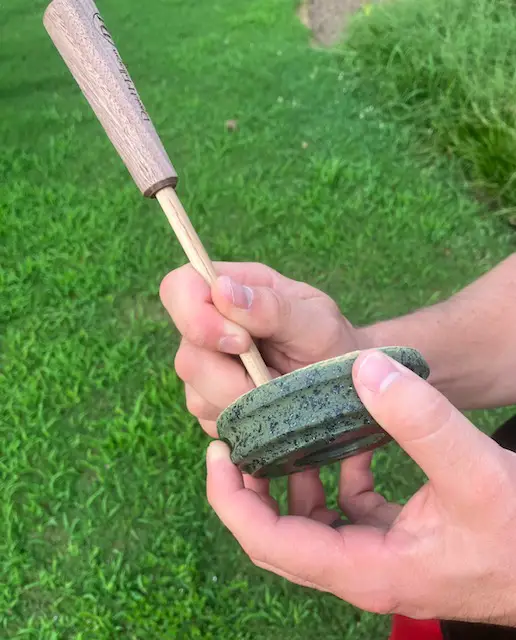
Choosing the Best Slate Turkey Call
Choosing a pot call can be confusing for even experienced turkey callers. When you are new to the sport, it can be downright daunting.
I recommend trying out a few different calls before you buy one if possible. Try to attend some call maker/turkey exhibitions where you can get your hands on and hear many different calls.
Each person will have individual preferences on what sounds good to him. The important thing is that you can consistently call with it and that it gives you confidence in the woods. Ultimately, the turkeys will be the judge of how good a call is. Because of this, I recommend carrying multiple calls for those days when the toms aren’t digging your “go-to” call.
The main things to consider when buying a turkey pot call are the surface material, the strikers you pair it with, and the call maker. The following is a brief overview of each.
Turkey Pot Call Surfaces
- Slate-Slate is the most popular turkey pot call surface. It specializes in soft, close-in-calling settings. It is also fairly easy to use for those just starting out. Weather is the enemy when it comes to a slate surface. High humidity and wet weather can make it nearly impossible to get out a good call.
- Glass- The glass surface can be a bit tougher to run than the slate. It has a higher pitch to “reach out there” to turkeys further away.
- Crystal- A crystal surface is going to be just a little softer than a glass surface, but overall the qualities are similar.
- Ceramic- Ceramic is a lot like slate, but it offers a little bit higher pitch and a more consistent calling surface when wet.
- Aluminum- Aluminum is a really loud surface. On windy days or days when you’re “trolling for gobbles,” aluminum is a good way to go. While not quite as piercing as the box call, an aluminum pot call is a decent alternative to the box call. Aluminum calls also make an all-around good call for many situations.
- Copper- Copper turkey pot calls are less common than the others on this list. This can be good if you hunt high pressured turkeys. They can be less forgiving and more difficult to run than an aluminum surface.
Strikers
Strikers will sound and feel different on each call you use them on. If you buy a custom call, the call maker will usually pair the pot call with a striker that works well with this call.
Hickory, dymondwood, osage, snakewood, black locust, and purpleheart are very popular striker woods that work well on a variety of pot call surfaces.
On top of the wood type, there are also one piece and two piece strikers which can have a rounded or flared tip. Lots to consider when choosing a striker.
Start with the striker that came with your call. After that, try a striker in one of the woods listed above and see how that sounds. Eventually, you will find strikers that pair well with each of your slate turkey calls.
Mass Produced Slate Turkey Calls
If you’re buying a slate turkey call from Amazon, Walmart, or your local sporting goods store, you will likely be buying a production call. This includes brands such as Primos, HS Strut, and Bone Collector.
You can find some good mass-produced calls, but you may have to try several before you find one that sounds good to your ear. Stay away from gimmicky calls. Try to purchase calls that aren’t made of plastic.
Quality Custom Slate Turkey Calls
There are many great custom slate turkey call makers. Darrin Dawkins, David Halloran, and Brad Roberts are just a few of the big-name pot call makers.
Darrin Dawkins has been making calls for over 20 years. One cool thing about his calls is that he offers a 100 percent, money-back, satisfaction guarantee on all his calls. You can call or email him to order a custom-made turkey pot call.
David Halloran doesn’t just make great box calls. He makes really good slate turkey calls too. In fact, his most famous call, the Crystal Mistress, won the NWTF’s DD Adams Award which recognizes the best-sounding friction call and striker in the country. You can read my review on his calls here.
Brad Roberts makes calls under his company name B&C Custom Calls. While he has cut down on production lately, you can still buy his calls on eBay or some of the turkey-hunting forums. You may also catch him at his booth at a turkey call maker’s exhibition. If you can get ahold of one, his slate calls are some of the best ever made.
How to Use a Turkey Slate Call
While using a slate turkey call does require two hands in most cases, it is generally easier to learn than a mouth call. The following steps will get you started on your journey to becoming a proficient turkey caller.
- Prepare the Surface for Calling- Refer to your callmaker’s instructions before doing any conditioning. Not all surfaces will need conditioning, and most will not need it every time you call. However, it can be hard to call on a surface that has not been properly prepared. Read my section on conditioning below for more information.
- Hold the Pot In Your Hand- Use the tips of your fingers to hold the pot away from the palm of your hand. Avoid pressing the call into your palm as most turkey slate calls are designed so that the sound exits out of the back of the call.
- Grip and Position the Striker- Pick up the striker and hold it just like you would a pencil. Don’t overthink this. It will likely come very naturally to you. Now hold the striker to the pot at about a 45 degree angle (“tilted a lil’ bit” for you non-math people). Put the tip of the striker on the conditioned section of the playing surface.
- Yelp- To yelp, you’re going to place your striker near the edge of the surface and make small semi-circles or j-hooks. Think of it as going from 12 o’clock to 8 o’clock (counter-clockwise) on an imaginary watch face. Keep practicing until you get the proper high-low cadence.
- Cluck/Cut- The single-note cluck is pretty simple on a pot call once you get the hang of it. Touch your peg towards the edge of the call. Flick the tip straight down. It’s a very quick motion. Now to cut, just cluck fast in one to three note sequences.
- Purr- For me, there is no easier call to purr on than a good slate turkey call. Lightly touch the striker to the surface and drag it across.
Note that when you are calling, it is best not to take your striker off the surface. This will help you build consistency in your calling.
The video below from Flextone does a great job of demonstrating how to use a turkey pot call.
Maintaining and Carrying a Turkey Pot Call
Conditioning
Each type of surface will require somewhat different steps to condition. As I mentioned above, your callmaker should have instructions for you.
A slate surface can be conditioned with sandpaper or Scotch-Brite pads. Choose a small section of the call near the edge to condition. If there is already a conditioned section, re-condition that. Use your sandpaper or Scotch-Brite to rub in a straight line in one direction. You can then blow the filings off the call. DO NOT rub in circles.
Glass and crystal calls can be conditioned in a similar fashion to the slate.
If you have a pot call with an anodized aluminum surface, you should NOT sand it. Conditioning this type of surface will damage it and cause it to oxidize over time. On occasion, wipe it down with an alcohol pad to keep it running smooth.
You can use a lighter or flame to draw moisture out of your slate surface and make it sound even better. Hold your lighter or candle upright and turn your call upside down. Move it towards the flame and around in circles. This process should be quick You can use a Scotch-Brite pad to get any soot off your calling surface.
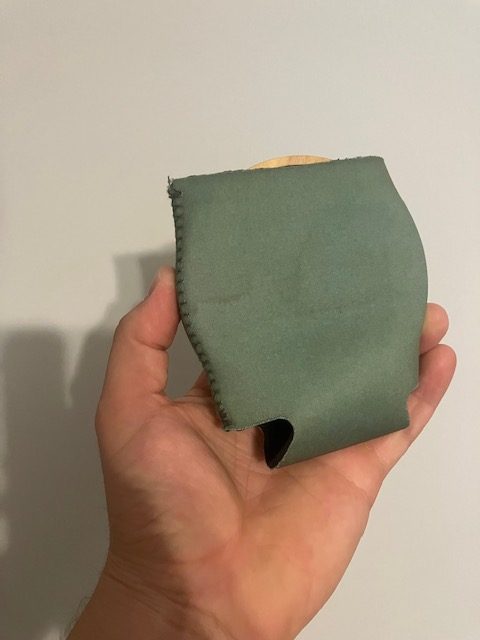
Storage
A tupperware container or a koozie makes a good offseason slate turkey call holder. They can be purchased inexpensively and insure your calls are ready to go next season.
If you’re too cheap for tupperware or koozies, you can also put your calls in old socks. Wash and dry the socks first, guys.
Carrying Your Pot Calls During the Hunt
Any vest, bag, or fanny pack designed for turkey hunting is going to have pockets especially designed for turkey frictions calls. There should be a separate compartment for the pots and the strikers.
Most of my hunting pants have a cargo pocket that perfectly fits a pot call in it. This is great for quick hunts when I’m trying to go in light.
Conclusion
Hopefully, this article has allayed some of your fears when it comes to pot calls (or is it a slate call?). Once you have chosen your call and striker, it can really be a simple call to use.
I feel most confident in the woods with my aluminum pot call by David Halloran. It is my go to call more times than not because of its versatility and ease of use.
With a little bit of searching and some practice, I’m confident that you can find a slate turkey call that you feel confident with too.
Enjoy this article? You’ll find a slate call on my list of the best gifts for turkey hunters.

